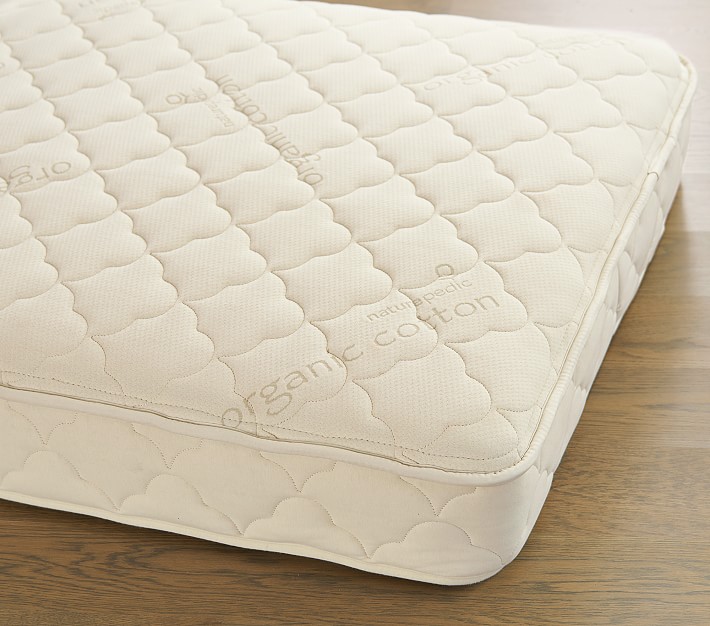are searching for Buying Guide: Organic Mattresses ? then yu are in right place Creating a green nursery? Given the amount of time your little dreamer will hopefully spend snoozing in his or her crib, an organic mattress is a great place to start.
According to the Environmental Protection Agency, chemicals left over from the manufacturing process of mattresses and many other common household items could actually make your baby sick. These nasty chemicals, known as volatile organic compounds or VOCs, evaporate over time, creating dangerous fumes that can aggravate existing medical conditions like asthma or allergies and even cause new and potentially dangerous health problems.
An organic crib mattress made from natural materials and produced without the aid of chemicals can go a long way toward protecting your child’s air quality and overall health.
However, organic mattresses can be costly and prone to damage, and questionable certification standards can make it difficult to know if you’re really getting what you paid for.
Before you find yourself up against a veritable wall of little green dream beds, take a moment to review this helpful buying guide.
Benefits of Organic Mattresses :
- Comprised of natural, chemical-free materials
- Free from chemical off-gassing associated with traditional mattresses
- Often made using responsibly sourced, sustainable products
Drawbacks:
- Expensive
- Prone to damage
- Not available in “waterproof” finishes
- Organic certifications can be misleading
Tips:
Settle on innerspring or foam.
Need to narrow your choices? Start by settling on a mattress style. Organic mattresses are available in both traditional innerspring models and organic latex foam. Although thought to be more comfortable, foam does not always breath well and can make your little one uncomfortably hot. Foam mattresses may also lose their shape and firmness over time, compromising your baby’s safety.
Innerspring mattresses, which are comprised of several layers of material supported by a bed of steel coils, are generally cooler and more durable than foam. However, unlike hypoallergenic foam, a traditional innerspring can become a reservoir for dust mites and dander. Furthermore, an innerspring’s complex structure is more likely to include inorganic material.
Learn the benefits and drawbacks associated with various organic materials.
Organic mattresses are available in a wide variety of organic materials, each with its own set of pros and cons. For example, wool is naturally water resistant and fire retardant, but it can aggravate allergies. If your child suffers from allergies, naturally hypoallergenic latex foam might be a better choice. Organic cotton is an excellent choice for sensitive skin; however, it won’t do much to stop diaper leaks from soaking deep into the mattress. Also easy on the skin, bamboo fiber boasts anti-fungal and antibacterial properties. That being said, it usually adds a pretty penny to the price. Even choosing Camping Air Mattresses, people like to buy Organic Mattresses.
When buying an organic mattress, it’s important to know what’s in it. However, being able to list the components won’t help you much if you don’t know anything about them, so be sure to do your homework ahead of time.
Be label savvy.
When it comes to labels, don’t believe everything you read. Under US-approved standards, products that claim to be “organic” or “made with organic materials” may still contain inorganic materials. Only products labeled “100% organic” need to be completely organic. (You can learn more about organic certifications, here.)
Mattresses are often too complex to be entirely organic, but while you’re not likely to find a “100% organic” mattress, you should look for a mattress made from 100 percent organic materials. For example, a mattress cover made from 100 percent cotton is different and preferable to a cover made from organic cotton. The better the quality of the organic materials, the more organic the mattress.
Make sure your organic mattress is fire-safe.
Opting for a mattress free from dangerous fire-retardant chemicals doesn’t have to mean opting out on fire safety. Slow burning and slow to ignite, natural materials such as wool provide a fire-safe alternative to mattresses treated with toxic chemical solutions while still meeting federal fire codes. Before you take an organic mattress home, be sure to ask about fire safety rating and whether or not the manufacturer has met federal codes.
Buy a water resistant cover.
While some organic materials like wool naturally repel water, few will survive a good soaking, and a “wet” mattress can quickly become a breeding ground for bacteria. If you want your crib mattress to last, you’ll want to protect it with an organic cover designed to withstand the average diaper explosion. Organic covers typically work by absorbing messes, wicking moisture away from the surface of the mattress. The cover can then be removed and washed.
Even if your mattress is “waterproof,” it’s a good idea to purchase a cover. Effective waterproofing usually requires the use of chemicals and/or inorganic materials, so an organic mattress that claims to be waterproof may be less effective than you might have hope. Bottom line: it’s better to be safe than sorry.
